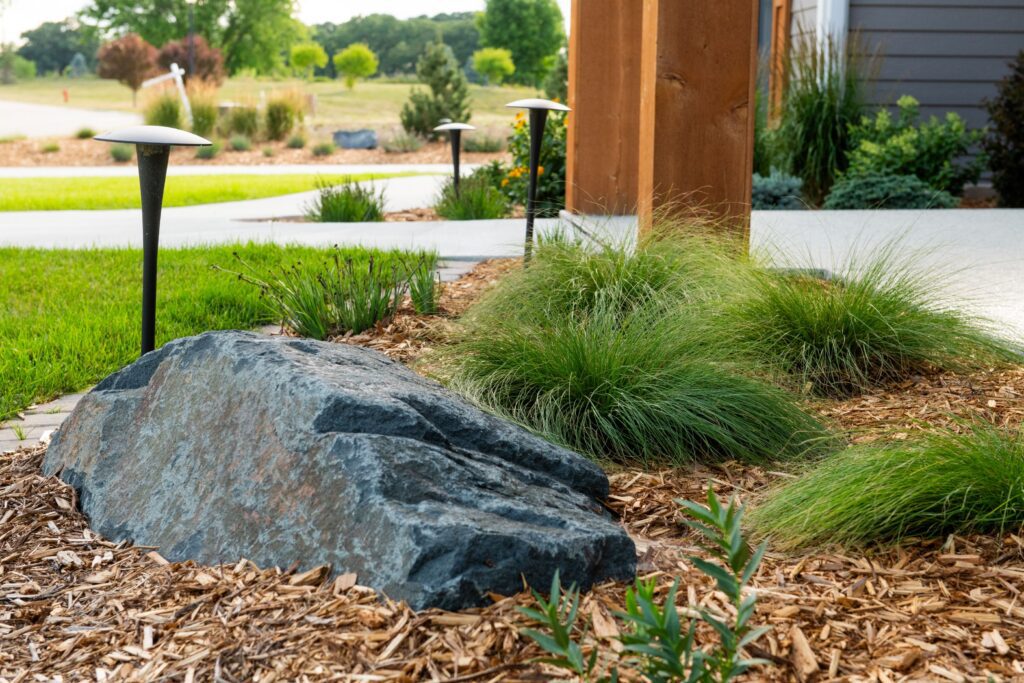
Creating a landscape that feels both functional and visually appealing year-round requires thoughtful planning, collaboration, and an understanding of the land’s natural features. In this project, we focused on blending aesthetic beauty with practical design, resulting in a space that evolves with the seasons and invites outdoor living. Here’s a breakdown of the key design elements used and the purpose they serve.

Project Objectives:
- Create a private outdoor living space that invites gatherings.
- Include an edible garden close to the kitchen.
- Provide seasonal color and interest.
One of the main goals for this project was to create privacy from the nearby road that sheltered more than traditional fencing. To achieve this, we implemented multilayer plantings using different plant heights, textures, and species. These layers create a natural barrier, while also adding dimension to the landscape.
Before
After
1. Multilayer Plantings for Privacy and Seasonal Interest
We selected trees that would not only provide privacy but also offer interest throughout the year. Some varieties bloom in spring, some turn vibrant colors in fall, and others hold their structure during winter.
Perennials were planted to fill in the middle and lower layers, and around the home, providing color and texture. Many of these plants bloom at different times throughout the year, ensuring that there’s always color.
This multi-layer approach not only adds depth to the landscape but also promotes biodiversity, creating a habitat for local wildlife and pollinators.


2. Natural Stone Patio and Seating
The backyard features a natural stone patio and tumbled wall-stone seating, which were chosen for their durability and ability to blend into the surrounding environment.
Natural stone creates a timeless, earthy feel that complements the overall design. It’s also durable and low maintenance, making it an excellent choice for outdoor spaces.
Tumbled wall-stone seating offers a natural aesthetic and creates an informal, inviting space where people can gather.
Before
After
3. Raised Garden Bed
A raised garden bed was incorporated for practical reasons as well as visual interest. Raised beds offer several advantages:
– They allow for control over soil quality, drainage, and nutrient levels, making them ideal for growing a variety of plants, including vegetables and herbs.
– Raised beds reduce the need for bending over, making them more accessible and comfortable to maintain.
– They are accessible and near cooking spaces, allowing for quick and easy use of veggies and herbs.
By placing the raised bed in a prominent area, it becomes both a functional garden space and a visual focal point within the landscape.


4. Dry Creek Bed and Boulder Accents
Incorporating a dry creek bed adds both an aesthetic and functional element to the landscape. This feature mimics a natural water pathway, adding movement and texture to the design.
Water Drainage: A dry creek bed can assist with drainage by directing water runoff during heavy rains, preventing erosion and pooling.
Visual Appeal: The addition of a dry creek bed brings a sense of flow to the space, drawing the eye through the landscape. Boulder accents were placed strategically along the creek bed to enhance the natural look and create balance.
5. Low-Voltage Lighting for Atmosphere
Lighting plays a crucial role in extending the use of outdoor spaces into the evening hours. For this project, low-voltage lighting was installed throughout the landscape, providing subtle illumination.
Lighting along pathways ensures safety, guiding visitors through the landscape after dark. By highlighting specific features like trees, stone seating, and the creek bed, the lighting adds depth and drama to the space. Low-voltage lighting is energy efficient and creates a soft, inviting glow without overpowering the natural beauty of the surroundings.

Designing for All Seasons
One of the guiding principles in this project was to ensure that the landscape would remain interesting and functional throughout the year. Trees and perennials were chosen for their seasonal variation, ensuring that spring blossoms, summer greenery, fall colors, and winter textures are all part of the experience.
Each design element, from the raised garden bed to the natural stone patio, was selected to harmonize with the environment, creating a space where form meets function. The result is a landscape that not only meets the homeowners’ needs but also works in concert with the changing seasons, allowing the space to evolve and thrive year after year.






